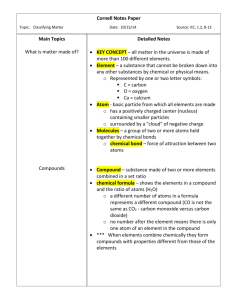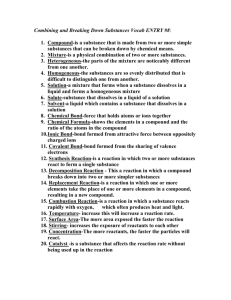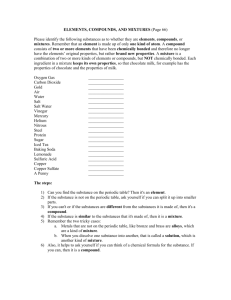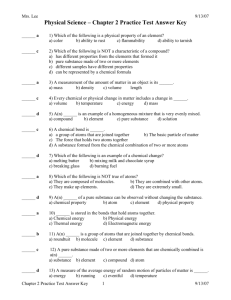Chapter 2 Pretest
advertisement
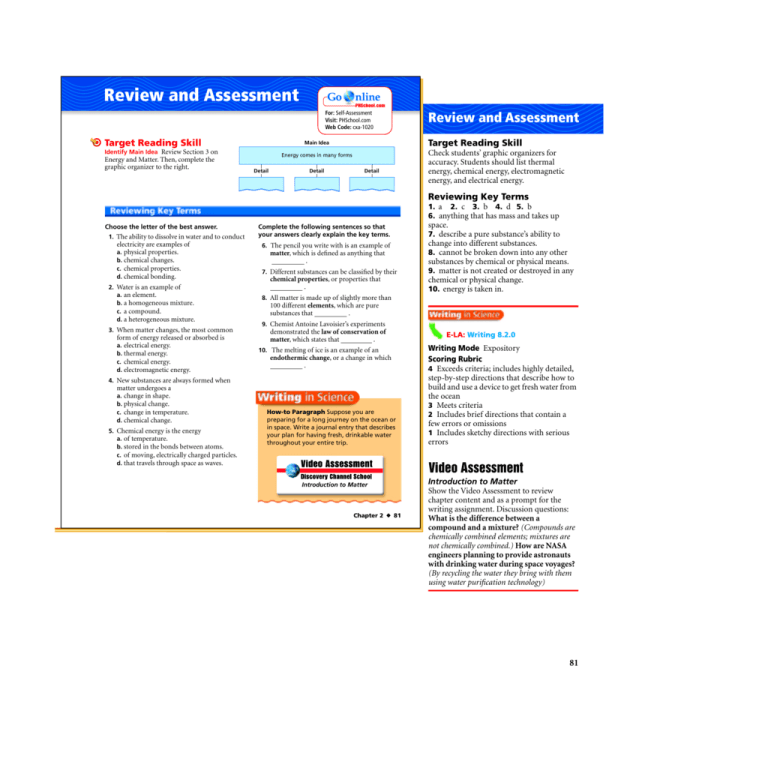
Review and Assessment PHSchool.com For: Self-Assessment Visit: PHSchool.com Web Code: cxa-1020 Target Reading Skill Energy and Matter. Then, complete the graphic organizer to the right. Target Reading Skill Main Idea Identify Main Idea Review Section 3 on Energy comes in many forms Detail Detail Review and Assessment Detail Check students’ graphic organizers for accuracy. Students should list thermal energy, chemical energy, electromagnetic energy, and electrical energy. Reviewing Key Terms 1. a 2. c 3. b 4. d 5. b 6. anything that has mass and takes up Choose the letter of the best answer. 1. The ability to dissolve in water and to conduct 2. 3. 4. 5. electricity are examples of a. physical properties. b. chemical changes. c. chemical properties. d. chemical bonding. Water is an example of a. an element. b. a homogeneous mixture. c. a compound. d. a heterogeneous mixture. When matter changes, the most common form of energy released or absorbed is a. electrical energy. b. thermal energy. c. chemical energy. d. electromagnetic energy. New substances are always formed when matter undergoes a a. change in shape. b. physical change. c. change in temperature. d. chemical change. Chemical energy is the energy a. of temperature. b. stored in the bonds between atoms. c. of moving, electrically charged particles. d. that travels through space as waves. Complete the following sentences so that your answers clearly explain the key terms. 6. The pencil you write with is an example of matter, which is defined as anything that . 7. Different substances can be classified by their chemical properties, or properties that . space. 7. describe a pure substance’s ability to change into different substances. 8. cannot be broken down into any other substances by chemical or physical means. 9. matter is not created or destroyed in any chemical or physical change. 10. energy is taken in. 8. All matter is made up of slightly more than 100 different elements, which are pure substances that . 9. Chemist Antoine Lavoisier’s experiments demonstrated the law of conservation of matter, which states that . 10. The melting of ice is an example of an endothermic change, or a change in which . How-to Paragraph Suppose you are preparing for a long journey on the ocean or in space. Write a journal entry that describes your plan for having fresh, drinkable water throughout your entire trip. E-LA: Writing 8.2.0 Writing Mode Expository Scoring Rubric 4 Exceeds criteria; includes highly detailed, step-by-step directions that describe how to build and use a device to get fresh water from the ocean 3 Meets criteria 2 Includes brief directions that contain a few errors or omissions 1 Includes sketchy directions with serious errors Video Assessment Introduction to Matter Chapter 2 ◆ 81 Introduction to Matter Show the Video Assessment to review chapter content and as a prompt for the writing assignment. Discussion questions: What is the difference between a compound and a mixture? (Compounds are chemically combined elements; mixtures are not chemically combined.) How are NASA engineers planning to provide astronauts with drinking water during space voyages? (By recycling the water they bring with them using water purification technology) 81 Checking Concepts Review and Assessment 11. Compounds—pure substances made up Thinking Critically 15. Fruit punch is a solution because its parts retain their individual properties but are evenly mixed. 16. Sample answer: The solution would taste salty so the salt would still be present. Boiling the liquid separates the water from the salt. 17. The reaction released energy. The temperature of the reaction mixture increased. Math Practice 18. 2 : 5; the compound P2O5 has two atoms Checking Concepts 11. What are three ways that compounds and mixtures differ? 12. How does a physical change differ from a chemical change? 18. Ratios The elements phosphorus and oxygen form a compound with the formula P2O5. What is the ratio of phosphorus atoms to oxygen atoms in the compound? 13. How are changes in matter related to changes in energy? 14. How do you know that the burning of candle wax is an exothermic change? Use the information and the diagrams below to answer Questions 19–22. Each diagram below represents a different kind of matter. Each ball represents an atom. Balls of the same color represent the same kind of atom. Thinking Critically 15. Classifying Which of the following is a solution: pure water, fruit punch, cereal and milk in a bowl? Explain how you know. A B C D 16. Problem Solving Suppose you dissolve some table salt in a glass of water. How could you prove to someone that the dissolving was a physical change, not a chemical change? 17. Interpreting Graphs A student has two liquids at the same temperature. The liquids react with one another when mixed. The graph below shows the change in temperature after the two liquids are mixed. Did the reaction absorb or release thermal energy? Explain your answer. Reaction Temperature vs. Time 19. Interpreting Diagrams Which diagrams 28 Temperature (ºC) of two or more elements chemically combined; elements combined in a specific ratio; properties differ from those of combined elements Mixtures—not pure substances; made up of two or more elements and/or compounds not chemically combined; parts not combined in a specific ratio; mixed substances retain individual properties 12. In a physical change, the same substance is present before and after the change. In a chemical change, new substances are produced. 13. Every physical or chemical change in matter includes a change in energy. 14. The burning wax releases energy in the form of light (electromagnetic energy) and heat (thermal energy). A change that gives off energy is an exothermic change. of phosphorus for every five atoms of oxygen. represent a single element? Explain. 20. Classifying Which diagrams represent pure 26 substances? Explain. 24 21. Interpreting Data How do the molecules in 22 22. Interpreting Diagrams Which diagram diagram A differ from those in diagram D? represents a mixture? Explain. 20 0 10 20 30 40 50 60 Time (s) Applying Skills Performance Assessment Compare the changes 19. Diagrams A and B represent single you recorded in your log with those of your classmates. Defend your opinions as to whether or not your observations describe physical or chemical changes. elements because each is made up of a single type of atom. 20. Diagrams A, B, and D represent pure substances. Diagrams A and B represent elements. Diagram D represents a compound because its two kinds of atoms are chemically combined in a set ratio. 21. A—a single kind of atom; D—two kinds of atoms 22. Diagram C represents a mixture because it contains several different kinds of substances that are not chemically combined. 82 82 ◆ Choose the letter of the best answer. 1. What is the best title for the chart below? A Chemical Properties of Some Compounds B Physical Properties of Some Elements C The Periodic Table of the Elements D Gases Found in Air S 8.3.b ? 5. The fact that matter is neither created nor destroyed in any chemical or physical change is called the A law of exothermic change. B law of endothermic change. C law of thermal change. D law of conservation of matter. S 8.5.b 6. How would you classify the burning of natural Helium Colorless; less dense than air Iron Attracted to a magnet; melting point of 1,535°C Oxygen Odorless; gas at room temperature A scientist did an experiment, described by the words and symbols below. Use the information to answer Questions 2 to 4. gas? A exothermic chemical change B endothermic chemical change C exothermic physical change D endothermic physical change S 8.5.c 7. Which diagram best represents a mixture of Teachers can monitor student progress and supply remediation when necessary. Standards Practice 1. B; S 8.3.b 2. C; S 8.5.b 3. A; S 8.3.b 4. A; S 8.5.c 5. D; S 8.5.b 6. A; S 8.5.c 7. C; S 8.3.b two kinds of gas molecules? S 8.3.b hydrogen ⫹ oxygen → water ⫹ energy 8. Sample answer: In a physical change, such 2. The scientist found that 2 grams of hydrogen reacted completely with 16 grams of oxygen. What was the total mass of water produced? A 8 grams C 18 grams B 14 grams D 32 grams A as melting or freezing, water remains the same substance: the compound H2O. In a chemical change, such as electrolysis, a reaction produces products with different properties than the compound H2O. B S 8.5.b S 8.3.b 3. The properties of the water produced by the reaction are A different from the properties of both hydrogen and oxygen. B the same as the properties of both hydrogen and oxygen. C the same as the properties of hydrogen, but different from the properties of oxygen. D the same as the properties of oxygen, but different from the properties of hydrogen. S 8.3.b C D 8. Water is a compound with the chemical formula H2O. Compare a physical change involving water with a chemical change involving water. How do the changes differ? S 8.3.b 4. Which pair of terms best describes the type of change that occurred in the reaction? A chemical and exothermic B chemical and endothermic C physical and exothermic D physical and endothermic S 8.5.c Chapter 2 ◆ 83 S 8.3.b Performance Assessment As students complete their observations and compile a list, have them identify common observations and make sure they classified observations in the same way. It may help to have volunteers make a poster or a large data table on the board for students to fill in. Students should identify changes that were easy to observe and classify as well as those that were difficult. Students should give an example of a change they had trouble analyzing. Teaching Resources Laboratory Manual TE • Standards Investigation Scoring Rubric The Standards Investigation Scoring Rubric will help you evaluate students’ work. If you shared the rubric in advance, students will know what is expected of them. 83




